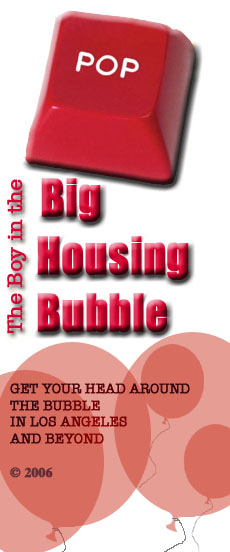EXTRA, EXTRA: Balloons Actually Burst!
 . . . . . *Photo from The Mumford Time Machine.
. . . . . *Photo from The Mumford Time Machine.Gwen Ifill, a senior correspondent with The NewsHour with Jim Lehrer, sat down this week with David Lereah, chief economist for the National Association of Realtors, to talk about the real estate market. During a semantical exchange, Lereah offered an interesting observation on physics, bubbles vs. balloons. He claimed balloons don't pop:
DAVID LEREAH: I don't like to use the word "bubble" because bubbles burst.Unfortunately, this just isn't true.
GWEN IFILL: Exactly.
DAVID LEREAH: Balloons don't burst. You can put air in a balloon and it can expand or you can deflate a balloon, where air comes out. So if you're looking at different metro markets around this country that got real hot over the last four years, I like to use the imagery of balloons because they're getting hot. You're putting more air into those balloons. The prices are going up. But now air can come out of the balloon rather than the balloon popping.
Balloons burst, same as bubbles.
Here's a physics lesson from Joseph Andersen a graduate student in the physics department at Harvard University in Cambridge, Mass. In this article, Mr. Andersen explains there are two ways to prevent a balloon from bursting. One is to just not inflate it. The other is to inflate it by a small amount. Tricky stuff. Now, here's what Andersen has to say about why balloons actually do burst:
Why do balloons burst anyway? Balloons are made of rubber, which is an elastic material, meaning, if you stretch it, it pulls back. In order to make a hole in the balloon, you need to push the skewer into the side of the balloon until the rubber in front of the point is so stretched that it breaks. Then two things can happen – either the balloon bursts, or it doesn’t. If the rubber you’re poking through is generally unstretched (like the end of an inflated balloon or an uninflated one), then the stretching due to the skewer is in a sense “local”, that is, only the rubber very close to the point is stretched and breaks., the rest of the rubber remains outstretched and holds together.
Around the hole the skewer made is a number of little cracks and tears in rubber. If the rubber is slack, these don’t spread and the balloon stays together. On the other hand, if the rubber is stretched, then it pulls on these cracks and tears and makes them larger and larger. Some of these tears very quickly become large enough that the balloon falls to pieces. This is when you burst a balloon by making a small hole in it, you still often end up with the balloon looking like it was torn to pieces.
— The Boy in the Big Housing Bubble




<< Home